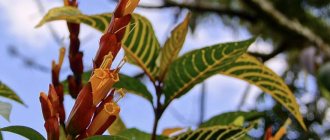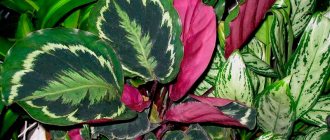Appearance and other characteristic features of the pachypodium
Pachypodium is a genus of very unusual succulents belonging to the Apocynaceae family. Its name is due to the appearance of the plant. Translated from Greek, pachys means “thick” and podos means “leg.” Accordingly, “pachypodium” is a “thick leg”. The genus is quite small. According to various sources, it currently includes from 25 to 30 varieties.
In nature, pachypodium successfully survives in the most extreme conditions.
In nature, the plant successfully exists in conditions that are difficult for humans to endure. It is common in southern and southwestern Africa, Australia and the island of Madagascar. Most often it can be found in Namibia, South Africa, Mozambique, and Angola. The plant clings to the smallest cracks in rocks with its roots, living on plains and plateaus under the scorching sun.
Followers of the Chinese teachings of Feng Shui purchase pachypodium to protect themselves from negative energy. It is also believed that the plant can help the owner by relieving any pain caused by the development of the inflammatory process.
The appearance of pachypodium largely depends on where exactly it grows. It can be a tree 6–8 m high with a thick trunk (up to 1.5 m), or a spreading, almost spherical shrub (3–4 m in diameter), or a completely miniature plant (25–30 cm high). At home, its height rarely exceeds 1–1.5 m. Pachypodium does not differ in growth rate, adding 3–5 cm per year. Lifespan depends on proper care. The plant can last in an apartment for 2–3 years, and 15–20 years.
Any pachypodium is a succulent. During the short rainy season, it stores moisture and nutrients in its thick, fleshy trunk, which then help it survive heat and drought. It compares favorably with other succulents by being unpretentious in care and lacking a dormant period.
The trunk is the place where the pachypodium stores “NZ” (water and nutrients)
The trunk of the plant has a gray-silver or olive tint. It is most often covered with densely arranged sharp spines. They are absent only in places of bends. Thorns are not only a means of protection against herbivorous insects. With their help, the pachypodium absorbs moisture from the surrounding atmosphere when fog descends or dew falls.
Pachypodium spines are leaves modified during evolution
Pachypodium leaves are collected at the top of the trunk, so the plant resembles a broom. They are quite thin and narrow. This is logical - the smaller the leaf area, the less moisture the plant loses due to evaporation. Under natural conditions, during drought, it often sheds its leaves, very much like a cobblestone, but in “captivity” this does not happen.
Pachypodium leaves are narrow and thin
Flowers that look like bright yellow, snow-white or pinkish stars add an exotic appearance. But they will have to wait at least 6–7 years for their appearance. Unfortunately, at home, even adult pachypodiums bloom extremely rarely. If this does occur, buds appear in late spring or during the summer.
Flowering pachypodium at home is a truly exclusive sight
Video: what pachypodium looks like
This plant is often confused with milkweed, also known as eurphobia. Both of them, when tissue is damaged, secrete a caustic milky-white juice. But if milkweed juice causes irritation and other negative consequences even when it comes into contact with the skin, pachypodium juice is dangerous to health only if it comes into contact with the mucous membrane or an unhealed wound. Nevertheless, for prevention, after any work with the plant, it would be useful to wash your hands thoroughly with soap. And, of course, the potty should not be placed where children and pets can reach it.
Euphorbia and pachypodium are slightly similar in appearance, and when damaged, they produce an acrid milky-white sap
Reproduction of pachypodium
Pachypodium is propagated by seeds, which you will have to buy, because it is difficult to obtain them yourself at home. Sowing is done to a depth of half a centimeter, the container is covered with glass or film and kept in a bright place at a temperature of 20 ˚C. When seedlings emerge, the covering is removed, but not suddenly, giving the seedlings the opportunity to gradually adapt to the conditions of the room. Strong seedlings are planted in separate pots and cared for like adult plants. However, it should be remembered that pachypodium grows from seeds very slowly.
How to plant and care for adenium
Propagation of pachypodium by cuttings rarely produces results, since parts of its stem do not form roots well, but there have been cases of successful rooting of the top of a plant whose base has rotted. It was only necessary to cut the pachypodium at a height of 15 cm with a sharp sterile instrument, treat the cut with charcoal powder, plant the top in a substrate for an adult plant and place it in a well-lit place.
Types of plants popular among amateur gardeners
The Pachypodium genus is quite small. Many of its representatives have surprisingly successfully adapted to the conditions of modern apartments, radically different from those to which they were accustomed in their historical homeland. The most popular among gardeners:
- Pachypodium Jayi (geayi). Under natural conditions, it is a practically non-branching tree, 3–5 m high, but at home it rarely grows more than 50–70 cm. The leaves are narrow, 1.5–3 cm wide, densely covered with soft “lint” on the underside. The spines are grayish, the color increases in intensity from the base to the end, changing to almost black. The flowers are white, the bases of the petals and the middle are bright yellow.
- Pachypodium Lamera (lamerei), also known as the “Madagascar palm”. In nature, it is rarely found anywhere other than this island, but at home this species is one of the most common. The trunk becomes woody and practically does not branch. It is very thick at the base. It is surrounded by tubercles in a spiral, each of which has three sharp long spines. The leaves are not pubescent, have a petiole 3–4 cm long. The length of the leaf plate is 20–30 cm, the width is 5–8 cm (in nature), at home – 10–12 and 2–3 cm, respectively. The flowers are cream or pinkish, the middle is yellow. They are quite large - about 10 cm in diameter.
- Pachypodium Lamera branched (ramosum). Natural hybrid. The trunk has the shape of a bottle, there are practically no thorns. There are many more of them on the shoots. The central vein stands out sharply on the leaves. The flowers are snow-white, up to 10 cm in diameter, collected in umbrella-shaped inflorescences.
- Pachypodium short-stemmed (brevicaule). The 50–60 cm tall trunk closely resembles a tuber. If it weren't for the spines and leaves, the plant would be very easy to mistake for a rock. The flowers are small, 3–4 cm in diameter, bright yellow. There are quite a few leaves.
- Pachypodium densely flowered (densiflorum). The trunk is thick, about 30 cm in diameter, olive in color. If it is thinner, the plant generally does not bloom, even in nature. In winter, with a lack of light, it may lose all or most of its leaves. At home it grows up to 80–90 cm in height. The flowers are bright yellow, then the shade gradually changes to orange.
- Saundersii, also known as Lundi's star. The trunk is in the shape of an almost regular ball, the shoots are very short - no more than 10 cm. There are relatively few thorns up to 2.5 cm long. The flowers are white, with a pinkish stripe in the middle of the petal. Characterized by abundance of flowering.
- Pachypodium succulentum. Tree-like plant, trunk up to 15 cm in diameter. A significant part of it is immersed in the ground. Only an intensively branching “crown” 60–90 cm high remains on the surface. At the base of each leaf, 5–6 cm long and 1–2 cm wide, there are two short spines. The flowers are about 4 cm in diameter, pale pink, the middle is bright scarlet.
- Pachypodium horombense. The plant is no more than 0.5 m high, the trunk is smooth, greenish with a silvery tint. Olive colored leaves. It branches intensively, shoots can extend almost from the base of the trunk. It grows very slowly. Flowers are up to 10 cm in diameter, arranged in groups of 2–5 on long stalks. Even plants aged 2–4 years can form buds.
- Pachypodium rosulatum. The trunk is very short, the branches are located almost vertically. The leaves are collected in small rosettes at the ends of the branches. The flowers are pastel yellow.
- Pachypodium southern (meridionale). Tree plant. In nature it reaches a height of 2–3 m, at home - 1–1.2 m. The trunk is brown-silver, the leaves are bright green. Flowers with a diameter of 12 cm or more, with a distinct aroma. The petals are pink, the middle is red.
Living conditions in the wild
Pachypodium or Madagascar palm is a succulent tree or shrub in the wild. Belongs to the Kutrov family. There are twenty species in total, the smallest are the size of a palm, and the largest ones reach the height of a three-story building.
The thorns, their prickly feature, are grouped in bunches and arranged in rings along the trunk. The spines grow simultaneously with the leaf blade, then their growth slows down, they harden, turning into needles sticking out in different directions. Pachypodiums are:
- dwarf up to 8 cm in height, up to 40 cm in trunk diameter or oval-shaped bush up to 4 m in height;
- branching/non-branching cigarette-like;
- trees of the type of giant cacti up to 5 m tall.
Optimal microclimate for growing pachypodium
In nature, pachypodium is accustomed to truly extreme conditions, which are almost impossible to recreate at home. Nevertheless, the plant has quite successfully adapted to an unusual microclimate.
The place for the pachypodium is chosen once and for all. He reacts very negatively to any movement. Even a slight rotation of the pot can cause all or most of the leaves to be lost.
Table: how to create optimal conditions for pachypodium
| Factor | Recommendations |
| Location | Window sill facing south, southeast, southwest. In summer, it is useful to expose the pot to fresh air, protecting the plant from rain and cold drafts. It must be carefully protected from the latter even in the apartment. The pachypodium is gradually accustomed to new conditions. |
| Lighting | Loves bright light and direct sunlight. It will not die in partial shade, but will stretch out unsightly. In autumn and winter, additional lighting will be needed with fluorescent or special phytolamps. In spring, the flower will need to be gradually accustomed to natural light again. |
| Air humidity | Not important at all. The plant is quite happy with the air in the apartment (usual humidity is about 50%). Pachypodium leaves are sprayed and wiped mainly for sanitary purposes. |
| Temperature | The plant tolerates any heat without problems, feeling quite comfortable at temperatures of 30ºC and above. In winter it should not fall below 15ºС. The best place at this time is the window sill above the radiator. Try to avoid sudden temperature fluctuations. Pachypodium Lamera can tolerate a short-term drop in temperature to 8–10ºС. |
Pachypodium is not afraid of direct sunlight
Description of the plant
- The houseplant Pachypodium is so similar to a palm tree and a cactus that they have come up with popular names: “thick leg” and “Madagascar palm”. Of course, the flower has nothing to do with the palm tree.
- It belongs to succulent crops that contain a lot of moisture in their trunk. And its homeland is Australia, Madagascar and Africa.
- The stem of the flower is very dense and fleshy, covered with sharp needles. Narrow and long leaves form near the top of the trunk. At the beginning of December, before hibernation, they fall off. Under natural conditions, the plant can grow into a tree: it reaches 8 meters.
- When grown at home, the height reaches only one and a half meters. Large, tubular-shaped flowers are collected in clusters. The petals open only during the day; in the evening they close. The color of the flower depends on the type of pachypodium.
- The plant grows very slowly and can live from three to fifteen years. Before you have such a flower at home, you need to know that the juice of the plant is a toxic substance. And the needles on the stem are very sharp.
- Therefore, it cannot be grown in rooms where there are small children and curious animals. Caring for the pachypodium plant should only be done with gloves.
Variety of Pachypodium species
Lemera
This particular species is often called the “Madagascar palm”. The plant has a very lush crown due to the large number of long leaves (up to 0.4 m). The stem part is thick, with numerous tubercles. There are many thick spines along the trunk.
The plant blooms with large flowers of pink or cream color. The species has a subspecies, Pachypodium Typica. These plants have pubescence on the lower part of the leaf. Another subspecies of Lamera is pachypodium branched. The leaves of this plant are wide, and large snow-white flowers are collected in umbrellas.
Saunders
The thick trunk resembles a ball. Wide leaves are located at the very top of the trunk. The flowers open with snow-white petals with pinkish stripes.
It will be interesting to read about Pelargonium.
Jayi
The height of this compact plant is only 50-55 cm. This species is very similar to Pachypodium Lamera. Only Jaya has very narrow leaves, reminiscent of a rapier. Flowers with large snow-white petals and a yellow center.
Densely flowered pachypodium
A small succulent that barely grows to 50 cm, but has a very lush crown of wide foliage. Yellow flowers bloom.
Short-stemmed type of pachypodium
The stems, growing up to 50-60 cm in diameter, have a grayish color. Therefore, the plant resembles a gray stone. The leaves located at the top are round and small in size. But the flowers are large, with yellow petals.
Succulent pachypodium
This plant has a large, rounded trunk. The flowers are bell-like, pink with a red tint.
Pachypodium horombenze
The plant blooms with large flowers with yellow petals. Large leaves are located on the top of a thick stem in a chaotic disorder.
Southern Pachypodium
It has a long silvery trunk, at the top of which there are a few leaves. But their number is compensated by very fragrant and unusual flowers: they have curled petals of red-pink color. The plant grows up to one meter.
Rosette pachypodium
A short but powerful trunk at the base of the plant. At the top of the trunk there are several bunches of branches. Blooms with beautiful yellow flowers. Grows up to 60 cm.
Rutenberg pachypodium
In nature it grows up to 8 meters and is very similar to a palm tree. The trunk is thick, with thorny branches and dark green glossy leaves. The flowers bloom with large, snow-white petals.
How to replant a plant correctly
Pachypodium, like other succulents, does not differ in growth rate. However, young plants need to be replanted annually. For adults, one procedure every 2-3 years is enough.
The plant does not need a large pot. Each time its diameter is increased by 2–3 cm. In this case, the container must be deep enough. Be sure to have one or more drainage holes. It is better to choose ceramic pots. The plastic ones are very light, the above-ground part can overweight, and the flower will tip over.
The pachypodium pot should be quite heavy and stable
Pachypodium does not need nutritious soil. In nature, it successfully survives on bare rocks. There is a special soil for sale for cacti and succulents, but experienced gardeners prefer to mix the substrate themselves. It is desirable that it be neutral or slightly acidic (pH 5.0–7.0).
- peat chips, coarse sand, universal soil for indoor plants or garden soil (3:3:1);
- turf and leaf soil, sand (1:1:3).
Characteristics and description
Pachypodium or in Latin Pachypodium comes from the Kutrovaceae family and is a perennial succulent in the form of a tree or shrub. It came to indoor culture from the hot places of Australia, southern Africa and Madagascar. Popularly, this succulent even received the nickname “Madagascar palm ,” although it has nothing to do with palm trees. Only its appearance in adulthood, when a tall, prickly stem is crowned with a tuft of long leaves, creates the impression of similarity with this tropical tree. The Latin name of the plant comes from the phrase “thick leg,” which indicates the impressive size of the stem.
In nature, the slow-growing pachypodium sometimes grows up to 10 m, while indoors - up to 30 cm (maximum for some species) or up to 1.5 m. You can admire the “green friend” for 15 years or longer, depending on the conditions of detention.
Some flora lovers notice in pachypodium a resemblance to milkweed, and this is not accidental. The plant is also poisonous and dangerous, but its juice does not leave burns on the skin. Still, it is better to avoid contact with milky sap, replant the tree very carefully and place it away from children and animals so that they do not get hurt by sharp thorns.
The leaves of the Madagascar palm are simple and entire and grow from the very top of the trunk. The stem of the tree is very thick, fleshy and covered with sharp spines. The flowers collected in brushes are snow-white, quite large and elegantly tubular in shape. They open up and delight the gardener with their beauty mainly during the day.
Pachypodium care at home
Pachypodium is very undemanding to care for. The plant easily forgives the grower some mistakes and some forgetfulness. The only reliable way to ruin it is improper watering. Therefore, it is he who needs to pay special attention.
Watering
From early spring to mid-autumn, the pachypodium is watered so that the earthen ball is constantly slightly moist. If there is an excess of water, the roots rot very quickly, the trunk becomes deformed, and if there is a shortage, the flower sheds its leaves. Let the soil dry completely to a depth of about 1 cm. If it is not too hot outside, it is enough to water the pachypodium once every 3-4 days. The best time for the procedure is early morning.
The plant has increased demands on water quality. It should be warm (28–30ºС) and soft. All succulents react negatively to excess chlorine and fluoride compounds in tap water. Therefore, if it is not possible to water the pachypodium with melt, rain or bottled water, it must be settled, filtered or boiled. Apple cider vinegar or citric acid will help soften the water (a few drops or granules are enough for 10 liters).
Fertilizer application
The plant does not need frequent feeding. It is enough to water it with a nutrient solution once every 12–15 days. Special fertilizer for cacti and succulents is diluted according to the instructions. The optimal ratio of nitrogen, phosphorus and potassium is 1:2:3.
Pachypodium is fed only with special fertilizers for cacti and succulents with a low nitrogen content
Any other fertilizing, especially natural organic matter, will do more harm than good. Pachypodium reacts very negatively to excess nitrogen.
Rest period
Pachypodium does not have a clearly defined period of rest. In late autumn and winter, the plant is watered very carefully. This is especially true for varieties that shed leaves. After massive leaf fall, it is recommended to stop watering completely for 4–5 weeks.
In mid-autumn, some varieties of pachypodium may lose all or most of their leaves - this is normal.
Feed the plant in winter no more than once a month. If you are satisfied with its condition, you can stop fertilizing for 2-3 months.
Video: tips for caring for a plant
Replanting a flower
Let's take a closer look at how to transplant pachypodium at home.
You can use purchased soil for pachypodium succulents, which is intended for cactus crops. They do it themselves. To do this, mix: turf, leaf soil, sand. All components are taken in equal proportions. Add crushed red brick chips and crushed charcoal to the soil mixture.
At the bottom of the container there must be a drainage layer made of fine building material. The layer should be no less than a third of the height of the container. When the plant is planted, a thin layer of fine gravel or crushed stone is sprinkled on top of the soil.
When the pachypodium is young, a transplant is needed every year. It is held in the spring. Adult flowers are replanted once every three years. They are transplanted using the transshipment method, taking care not to damage the roots of the pachypodium.
With the arrival of spring, shoots begin to grow. It is necessary to gradually increase watering. And be sure to feed with complex mineral fertilizers. Do this once a month. Fertilizer is used for cactus crops.
Liquid fertilizer is diluted with water and watered. When the pachypodium is transplanted, it is not fed for a month. Flowering begins only 6 years after planting. And if the care was incorrect, then you may not wait for flowering.
Common problems that a beginning gardener may encounter
Most mistakes made by the grower out of ignorance will not destroy the pachypodium. But such oversights negatively affect the appearance and decorativeness of the plant. The flower itself will help you understand what exactly doesn’t suit him. You just need to learn how to correctly interpret the “signals” given to him and react to them.
Table: how pachypodium reacts to errors in care
| What does the plant look like? | What is the reason? |
| The tips of the leaves dry out and they themselves turn yellow. | Regularly drying soil in a pot. |
| The leaves lose their tone, the roots and trunk rot, the shoots droop. | Abundant watering, especially in combination with low room temperatures. The worst case in such conditions is short-stemmed pachypodium. |
| Leaves and shoots become wrinkled and turn black. | Frequent drafts or sudden temperature changes. Or watering with cold water. |
| The leaves fall en masse without drying out. | In mid-autumn this is natural for some varieties. At other times, “leaf fall” is provoked by a change in the position of the pot. |
| The shoots become thinner, the leaves become smaller and turn pale. | Lack of light. |
Blackening leaves mean that the pachypodium is suffering from cold drafts
Types of pachypodium domestica
In the natural environment, there are more than 20 species of Pachypodium. Some of them have taken root well at home.
Pachypodium lamerei / Pachypodium lamerei
A tree with an erect, thick stem strewn with large thorns. The lower part is thickened. Spiral-shaped thickenings run along the entire trunk. The top is decorated with a rosette of elongated lanceolate leaves attached to the base by long petioles. It blooms with large cream flowers with a soft pink tint. The throat of the flowers has a yellow tint.
Pachypodium geayi
A tree with a thorny thick trunk. The spines are gray with a black tip. Dark green leaves with a vertical brown-red stripe in the center are covered with delicate hair. The flowers are snow-white with a yellow spot in the center. The height of the tree is up to 0.5 m.
Pachypodium brevicaule
A spiny, succulent tuberous stem, the diameter of which reaches 0.6 m. When there are no leaves, it merges in shape and color with the stones surrounding it. It blooms with yellow small flowers of an elongated shape.
Pachypodium saundersii
The height of the spherical stem reaches a little more than a meter. The spines are few. The leaves are lanceolate, wide, and slightly pointed at the end. It blooms magnificently with white flowers with lilac stripes.
Pachypodium succulentum
The height of the tree is up to 0.5 m. The diameter of the thickened lower part reaches 0.15 m. It has numerous side shoots, their length reaches 0.9 m. The shoots are strewn with long spines and lanceolate pubescent leaves. It blooms in summer with pink flowers with a scarlet throat. The flowers look like bells.
A thorny tree with a silvery powerful stem stands firmly in a flowerpot. The graceful tuft at the top adds a playful touch to its look, and the bright flowers add charm. Pachypodium is an original plant that selflessly gives its owner joy and a sense of security.
Sources:
https://prorastet.ru/komnatnye/pahipodium-razmnozhenie-iz-semyan-i-uhod-v-domashnih-usloviyah https://azflora.com/pachypodium/pachypodium-iz-semjan.html https://komnatnie- rastenija.ru/pahipodium-uhod-v-domashnih-uslovijah/
Diseases and pests that attack the plant
Any succulents are unattractive to pests. In the case of pachypodium, in addition to the dense skin, there are additional protective measures - caustic juice and thorns. But even this does not stop some insects. A much greater danger is posed by rot, which quickly develops when the plant is not watered correctly. Processing a flower causes certain difficulties, because it is impossible to do it manually. Therefore, you will have to deal with problems using spraying.
Getting rid of some diseases or pests is quite difficult. And if you start the process, all that remains is to throw away the plant. Therefore, special attention should be paid to prevention:
- placing all newly acquired indoor plants in quarantine for at least 2–3 weeks;
- regular inspection of the collection and immediate isolation of specimens with suspicious manifestations;
- placing indoor flowers and bouquets as far from each other as possible;
- daily ventilation of the room;
- spraying the flower at least once every 2-3 weeks to remove accumulated dust;
- weekly irradiation of the plant with a quartz lamp for 2–3 minutes;
- loosening the soil (once a week is enough);
- sterilization of tools, pots, soil, washing hands before any work with the plant.
Pests and diseases of pachypodium
Diseases
When grown indoors, pachypodium is highly sensitive to too much moisture, and this is expressed in the appearance of various rots. In order to protect the bush from fungal disease, it must be properly watered. It should also be taken into account that such a succulent plant tolerates drought much more easily, but stagnation of water in the substrate can cause rotting and thinning of the stem, as well as blackening and flying of the leaves. As soon as you notice that the bush has begun to rot, you should immediately stop watering and put it in a warm place. The plant and soil mixture in the pot must be sprayed with a solution of a fungicidal preparation, and in order to prevent relapses, the watering regime must be reviewed.
Harmful insects
If the air humidity in the room is too low, then spider mites can settle on the plant and suck out the cell sap from the bush. It is almost impossible to see such a mite with the naked eye, but a sure sign that the bush is occupied by such a pest is the presence of a thin web on its surface. To get rid of this pest, the pachypodium must be thoroughly rinsed under a warm shower, and it is also recommended to increase the air humidity in the room. To do this, every evening the plant must be moistened from a sprayer with well-settled lukewarm water. In the case when there are a lot of ticks on the bush, acaricides such as Actellik, Fitoverm, Aktara or Akarin are used to destroy them.
If the room is relatively hot and the air humidity is low, then thrips can settle on the pachypodium. This pest also sucks cell sap from the flower. In this case, light-colored dots and silvery stains form on the front surface of the leaf plates. At the same time, the harmful insects themselves are located on the underside of the foliage. You can get rid of such a pest using the same drugs that are used in the fight against spider mites.
Varieties
2.1. Pachypodium lamerei
Perennial succulent plants with a height of 60 cm to 5 m in their natural habitat. With age, these succulents form a thick, succulent, sparsely branched trunk of a dark green or brownish color with numerous tubercles. At the tops of the tubercles there are thick, short, sharp needles. The length of the needles can reach from 2 to 6 cm. At the tops of the trunks there is a lush crown, consisting of oblong, narrow leaves, slightly bent along the central vein. The lower surface of the leaf plates has a lighter shade. During the flowering period, large, white, attractive flowers with a diameter of 5 to 8 cm appear in the crown. The flowers have a pleasant aroma, but appear only on adult plants with a height of 180 cm and above.
2.2. Pachypodium saundersii
Perennial succulents with a thick, turnip-like caudex at the base. The caudex is covered with greenish, brown or silvery-gray bark and reaches a diameter of 1 meter. The stems are sparsely branched, curved, reaching a length of 1 m. The leaves are green, lanceolate, glossy, bent along the central vein, from 3 to 8 cm long, on short petioles. The edges of the sheet plates may be corrugated. The spines are short, straight, sharp, located on the stems of plants. The flowers are large, showy, fragrant, white or pinkish.
2.3.Pachypodium geayi
An unusually attractive succulent with a thick, succulent, bottle-shaped stem, which in its natural habitat can reach 4 - 8 m in height. The stems are glossy, silver-gray or light green, abundantly covered with thick, straight spines. The leaves are dark green, glossy, entire, narrow, linear. The central vein is highlighted in a lighter shade. The leaves form a lush crown at the tops of weakly branched stems. The flowers are white, with rounded petals, and fragrant.
2.4. Pachypodium bispinosum or two-spined - Pachypodium Bispinosum
A relatively compact shrub with a round, thick caudex at the base, reaches a height of 120 cm. The caudex is covered with brownish or gray bark. The stems are branched, curved, and are often located at the top of the caudex. The leaves are glossy, green, long, on short petioles. The stems of the plant are abundantly covered with long, brownish, straight spines. The flowers are attractive, bell-shaped, up to 1.5 - 2 cm in diameter, solitary, pink, appearing on the tops of the stems.
2.5.Pachypodium rosulatum
Attractive, slow-growing succulents with thick, branching stems at the base. The stems bear short, thick, straight spines. At the tops of the stems there is a crown formed from glossy, belt-shaped, dark green, entire leaves. Young leaves may have a burgundy tint. The central vein is highlighted in a lighter shade. The flowers are very large - they can exceed 7 cm in diameter, yellow, collected in small inflorescences on the tops of long, thin peduncles. There is no flower aroma.
You might also be interested in:
Varieties of Pachypodium
Two varieties of pachypodium can be observed - shrubs and trees, some of which are quite large. The shape, as a rule, depends mainly on the environment and on the frequency of rain in a particular area. The thick trunk of this plant performs a very important function - it is able to accumulate and retain moisture. This helps it survive in drought conditions.
In nature, you can also find dwarf species of this plant, only up to 8 centimeters in height, and if they do not yet have leaves, they become like stones. And there are bottle-shaped or oval trunks, and their leaves are located only at the very top. There are also trees with strong branches.
A variety of indoor pachypodium is Pachypodium lamerei (Lamera). In an apartment, this plant usually reaches a height of no more than 1 meter, and it grows very slowly. The spines on the thick trunk are not single, they are grouped in twos and sometimes three. Thorns appear on plants most often along with leaves and usually grow around the table. As the plant matures, the thorns first harden and then fall off completely, so very old specimens of the plant have very smooth trunks.
The flowers of homemade pachypodium are white and very beautiful. But in the wild there are red, yellow and pink ones. Since the plant matures very slowly, it begins to bloom quite late, at about the age of 6-7 years.
IMPORTANT It is forbidden to keep this plant in the nursery because of its thorns and poisonous sap.
Watering pachypodium
Like any other plant, pachypodium needs proper watering:
- in spring and summer, the plant is provided with abundant watering, and it should be done quite often, since the soil itself should always remain slightly moist;
- during the dormant period that occurs in winter, watering should be stopped completely;
- excessive watering can have a detrimental effect on the pachypodium, so you need to make sure that the soil is not too wet, as this will lead to the leaves falling off;
- It is not allowed to use excessively cold water for watering, as this leads to the fact that the young leaves begin to darken.
Note! Watering the pachypodium should be done using soft water, which has been pre-settled for at least a day, and it should not be cold or hot
Pachypodium (pachypodium) lealii var. saundersii f. 'compactum'
Reproduction
Apical cuttings rarely take root, so pachypodium is grown from seeds. Before sowing, they are soaked for a day in warm water. The best substrate for planting is damp, fine sand. Seeds are sown to a depth of 0.5 cm and covered with film. The temperature is maintained at least 22 °C. Periodically moisten the sand with a spray bottle - it should always be slightly damp. The timing of seed germination depends on their quality, storage duration, and germination conditions. They can hatch in a few days or “sit” in the soil for up to six months.
The peculiarity of Pachypodium Lamera is that it is propagated by separating branches growing at the base. The cuttings are cut in the summer, dried for about a week and placed in a sand-peat mixture. Choose a bright place and maintain stable humidity. Cuttings take root slowly, some never take root.
How to properly care
Pachypodium, due to its distribution area, tolerates direct sunlight. Therefore, it can be grown on the south side of the building without fear that the plant may get burned.
Some varieties of pachypodium have a well-deserved reputation as plants for beginners, because they are easy to care for, reproduce well from seeds and bloom well
For them, it doesn’t even matter if there is high humidity or constant spraying.
Some species can live and grow even on an ordinary windowsill throughout the year. But those who want to get a gorgeous plant from a small bush should know the basic rules of how to care for a young pachypodium.
Lighting
Due to the fact that the birthplace of this palm is a number of African countries, it can easily withstand the rays of the sun. Pachypodium loves sunbathing, so it will be comfortable on the windowsill on the south side of the building.
If there is slight partial shade, this is not fatal, but prolonged and frequent lack of light can cause a thinner trunk and its curvature.
Temperature
The temperature at which pachypodium sanders and other varieties can be grown should not be lower than 16 degrees. The only plant variety that can grow normally at lower temperatures is Lameri, which can overwinter at a temperature of 8 degrees. In summer, if the weather is good, you can take the pachypodium out into the fresh air. A balcony or veranda is best.
Therefore, you should not open the window in cold weather, because even after a short stay in a draft, the palm leaves will fall off and become stale, and the trunk itself will become very soft and limp. As a result, this will lead to the death of the entire plant.
Watering
For pachypodium, both insufficient and excessive watering are equally dangerous. Therefore, in the summer it is necessary to first find out exactly how much water the plant will need.
This can be determined by the degree of drying of the soil layer by 1.5 centimeters. It is best to test the soil using an ordinary match. If grains of earth remain on it, then there is no need to water the plant.
In winter, it is much more difficult to correctly calculate the frequency of watering, since in winter the temperature becomes lower, and evaporation will be the same.
The palm tree will begin to consume less water, so even a small excess of water will be dangerous for it. As a result, the trunk may rot. But, if watering is insufficient, the palm tree will begin to shed its leaves. It's not fatal to him.
Humidity
Pachypodium is called a plant for beginners because it does not require special care. For example, pachypodium has no requirements for humidity, nor for spraying. Pachypodium tolerates unhumidified, dry air very well. The container with the palm tree can generally be placed close to the battery.
Fertilizer
If you need to make the pachypodium bloom, you need to fertilize and feed the plant. To do this, use fertilizer that has the lowest nitrogen content. Twice a month, that is, every 14 days, the flower must be fed with fertilizers. Special complexes that are used for cacti are best suited.
Note: it is not advisable to overfeed the plant, this can cause deformation of the trunk, and can also cause cracks and breaks to appear.
Transfer
Pachypodium is transplanted twice a year. A young plant needs not two, but one transplant per year. Most often, this procedure is carried out immediately after winter and before the cold weather sets in.
One of the important conditions for replanting: good drainage in the pot. It should occupy no more than one third of the total volume of the pot. Expanded clay, pebbles or aquarium soil can be used as drainage.
The transplantation procedure is specific, because the trunk of the Madagascar palm tree is too thorny, and the size of its thorns can penetrate even protective gloves. For additional protection, it is recommended to wrap it in a thick cloth in a couple of layers, and then move the plant into a pot.
Comfortable temperature conditions
In order for the pachypodium to become a decoration of your interior, all you need is to provide it with a warm location. This plant does not tolerate cold and temperatures below 15 degrees (with the exception of Pachypodium Lamera, which can tolerate a cool winter from 8 degrees Celsius). Lower temperatures compared to the active season have a beneficial effect on the attractiveness of foliage and flowering, but such a decrease should still remain within the usual ranges of indoor indicators. Pachypodium is a heat-resistant crop that will cope well even with the heat. Not only in summer, but also from March to September, the plant can easily withstand even air temperatures above 30 degrees Celsius.
The Madagascar palm tree is not afraid of a summer “vacation” in the open air. The pachypodium can be taken out into the fresh air in June and kept in the garden or on the balcony until the autumn cold snap. But when choosing a new place for the plant, try to reliably protect the false palm tree from precipitation and drafts. There is no need to reduce lighting when exposed to fresh air: the pachypodium will feel great even in the most brightly lit place. True, it is better to soften the transition by gradual adaptation both during the take-out and when returning back.
Pachypodium horombense. © Bernardo Ruiz
Reproduction methods
It is most convenient to grow indoor pachypodium from seeds, especially since the seed material of the miracle cactus can be purchased without any problems at a flower shop or on a specialized website. Sowing is carried out as follows:
- A shallow container is filled with soil mixture for cacti.
- The seed is soaked for 3 hours in clean water or a weak solution of a growth stimulator.
- Pachypodium seeds are scattered over the surface of the substrate and sprinkled with a thin (about 1 cm) layer of sand-earth mixture.
- The crops are sprayed through a sprayer with settled water at room temperature.
- The container is covered with a transparent film and placed under diffused light.
At a temperature of +20 °C, the first shoots will emerge from the ground in 2–4 weeks. During this time, the greenhouse is ventilated daily and the surface of the substrate is moistened as necessary. When most of the seeds germinate, the shelter is removed. In the phase of 3-4 leaves, seedlings are planted in separate pots.
Experts recommend vegetative propagation of pachypodium only as a last resort. For example, if the base of the trunk is rotten and the pet needs emergency help. To do this, cut off the healthy top of the plant, thoroughly rinse the wound to remove the milky sap, dry it and treat the cut area with crushed charcoal. Pachypodium cuttings are rooted in coarse sand at +24…+26 °C. There is no need to water the seedlings heavily, otherwise their stems will rot. With the appearance of young roots and leaves, the cuttings can be transplanted into a nutrient substrate.











